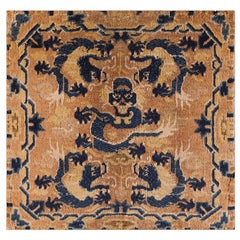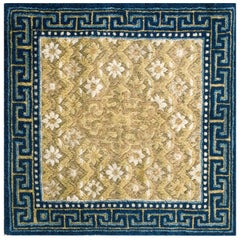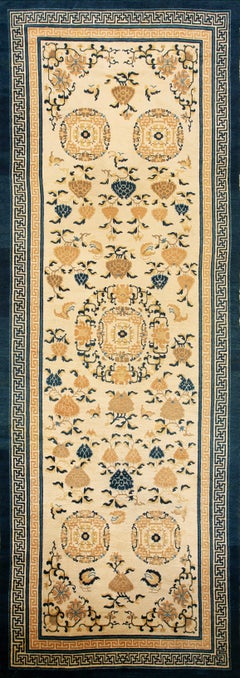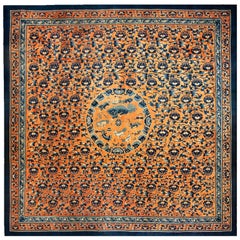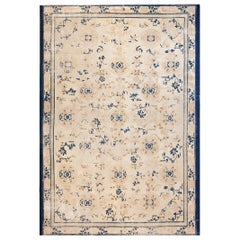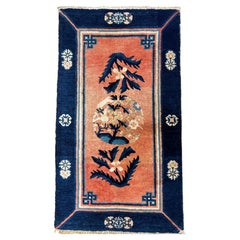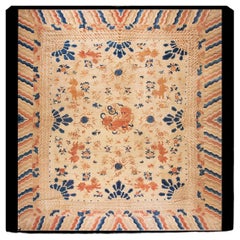1840s Chinese and East Asian Rugs
6
to
1
6
6
6
6
53
562
3,322
983
2,128
627
319
204
129
1,129
187
45
33
79
60
70
22
Width
to
Length
to
6
6
6
6
6
Period: 1840s
Mid 19th Century Chinese Ningxia Throne Back Rug ( 2' 3" x 2' 3" - 68 x 68 )
Located in New York, NY
Mid 19th Century Chinese Ningxia Throne Back Dragon Rug
2' 3" x 2' 3" - 68 x 68
Category
Chinese Antique 1840s Chinese and East Asian Rugs
Materials
Wool
Mid 19th Century W. Chinese Ningxia Rug ( 2'4" x 2'4" - 70 x 70 )
Located in New York, NY
Mid 19th Century W. Chinese Ningxia Rug ( 2'4" x 2'4" - 70 x 70 )
Category
Chinese Antique 1840s Chinese and East Asian Rugs
Materials
Wool
Mid 19th Century Chinese Ningxia Rug ( 2' 2" x 2' 2" - 66 x 66 cm)
Located in New York, NY
Mid 19th Century Chinese Ningxia Rug ( 2' 2" x 2' 2" - 66 x 66 cm)
Category
Chinese Antique 1840s Chinese and East Asian Rugs
Materials
Wool
Mid 19th Century Chinese Ningxia Gallery Carpet (5'8" x 16'6" - 173 x 473 cm)
Located in New York, NY
Mid 19th Century Chinese Ningxia Gallery Carpet (5'8" x 16'6" - 173 x 473 cm)
Category
Chinese Antique 1840s Chinese and East Asian Rugs
Materials
Wool
Mid 19th Century Chinese Ningxia Carpet ( 17'10" x 17'10" - 545 x 545 )
Located in New York, NY
Ningxia North Central China
17'10" x 17'10"
Circa 1850
Warp: cotton, off white, handspun, Z-4-S
Weft: cotton, off white, handspun, 2 shoots alternating
Pile: wool, 3 strand, handspun
Knot: asymmetric, open left, 48 knots per square inch
Sides: one cord, offwhite cotton wrapped
End: no original finish
This is a particularly large example of a Mandarin official’s carpet with a central medallion displaying nine lion dogs collectively symbolic of success on the national Chin Shih examination which provided guaranteed entry into the national administrative bureaucracy and the wealth devolving therefrom. The nine lion dogs are a rebus for success in the national bureaucracy. The apricot ground features 11 full or partial rows of tree paeonies, flower and stem. This carpet is particularly large and clearly was made for a highly placed official or the wealthy family of a recent graduate of whom great things were expected. The principal was probably Buddhist as indicated by the embroidered ball and precious objects in the medallion. The clouds surrounding the lion dogs form a broken, polychrome circle rather than the usual continuous cloud wreath. This is one of the several features indicating a bespoke order rather than a piece made for the market. Another indicator is the exceptional size, as the standard square Ningxia Mandarin carpet is about 12 to 14 feet square. The main border continues the colour combination, with a now apricot ground and paeonies among floral arabesques. The blue inner stripe is unusual with butterflies alternating with paired peaches...
Category
Chinese Antique 1840s Chinese and East Asian Rugs
Materials
Wool
Mid 19th Century Chinese Ningxia Carpet ( 9' x 13' - 275 x 395 cm )
Located in New York, NY
Mid 19th Century Chinese Ningxia Carpet ( 9' x 13' - 275 x 395 cm )
Category
Chinese Antique 1840s Chinese and East Asian Rugs
Materials
Wool
Related Items
Small Late 19th Century Chinese Carpet with Salmon Pink Ground
Located in Firenze, IT
In the vast range of Chinese carpets, all Chinese civilization is represented and in the elements that make up the design, all Chinese philosophy is represented, the religions with B...
Category
Chinese Chinoiserie Antique 1840s Chinese and East Asian Rugs
Materials
Wool
Early 20th Century Handmade Chinese Ningxia Square Throw Rug
Located in New York, NY
An antique Chinese Ningxia square throw rug handmade during the early 20th century.
Measures: 2' 3" x 2' 4"
The craft of the hand-knotted carpet in China, and the surrounding areas including Mongolia and Tibet, extends into the early centuries of the first millennium, C.E., but we really have a firm grasp only beginning in the later 16th century with large, very coarsely woven carpets, often depicting dragons, created for the Imperial Forbidden City palaces. Chinese carpets have always been commercial and there are no tribal groups responsible for any of the carpet weaving strains.
When the Ming Dynasty fell in 1644, with no Imperial patrons, production moved to the city of Ningxia in north central China where several workshops turned out more finely woven pieces for the Mandarins of the administrative Ch’ing bureaucracy and well-to-do merchants. Ningxia was the major Chinese carpet center up through most of the 19th century, with first allover and then medallion designs on cotton foundations in medium weaves. Palettes were initially limited to yellows, dark blue and cream, but later widened to include reds, browns and even green. These antiques were the first Chinese carpets to be exported to the West and they fitted in well with the craze for Chinese blue-and-white porcelain in the second half of the 19th century. Ningxia also wove shaped and rectangular small rugs for saddle underlays, chair (“throne”) seats and shaped backs, pillar carpets with dragons or monks for Buddhist monasteries, and long divided runners for monastery meditation halls. These small rugs are among the most collectible of all Chinese weavings.
Weavers from Ningxia set up workshops in the capital Peking (Beijing) in the 1860’s and began weaving Western room sizes for export, primarily to America. In blue – and – white and polychrome palettes, with round wreath medallions, precious objects, seasonal flowers, paeonies, lotuses, fretwork, clouds, butterflies and bats, all relatively spaciously drawn. The round “Shou” (Good Luck) character is also a prominent decorative motif. There are also a few Peking landscape pictorials with pagodas, houses, bridges, waterscapes and boats. Peking carpets were woven right up until WWII and production began again after the Cultural Revolution around 1970. They are moderately well-woven, on cotton foundations, exactingly executed and indisputably Chinese. Many are in the blue-and-white style. Nothing else looks like a Peking carpet and for a Chinese “look” in a room, they are absolutely indispensable. Sizes range from scatters and a few runners, through the popular 9’12’ size, to large carpets over 20’ which must have been special orders. The earliest Peking Revival carpets are pliable and fairly thin, but they became heavier and more compact in the 20th century, in competition with Art Deco carpets from Tientsin. The modern, post- 1970, pieces are in the traditional Peking style, but are a little too regular and neat. Exactitude has been favored over character, as hard to explain that as it is.
There are a number of all-silk and silk-and –metal thread pieces, many with inscriptions purporting to link them with rooms in the Imperial palaces, bringing very substantial auction prices, but none are really antique. The genre emerged after WWI and the present demand comes from mainland Chinese. The silk piles often stand in pattern relief against flat woven gold metal thread grounds. The inscriptions are apocryphal, the rugs are flashily opulent, perfect for nouveaux riches.
The Art Deco period between the two World Wars saw a distinctive carpet industry developing in Tientsin (Tianjin) in northeastern China. These are highly prized for their transitional design character, neither overtly Chinese, nor abstractly modern/contemporary. Woven exclusively for export, usually by and for American firms, such as Nichols and Elbrook, they are totally in the “Jazz Age Modern” style of the 1920’s, often without borders, with abstract or abstracted patterns, and only with, at best, a few Chinese-y pattern elements. Vases asymmetrically placed in the corners are features of some of the more Chinese-y carpets. Open fields with floral sprays and branches growing in from the edges are anther design innovation. Often, Chinese motives have been re-imagined in more sharp-edged, abstract manners. Some have no references whatsoever to natural elements. The patterns are sharp and the rugs are never subdued, soft or restrained. The rugs are heavily constructed, with crisp, unfading dyes and medium to medium coarse weaves on cotton foundations. All are extremely well-executed, with none of the vagaries, variations or twists found on even high-quality Persian rugs. The majority are in the 9’ by 12’ format and a surprising number can be found in top condition. There also was a substantial production in Peking from, especially from the Fette factory. Elliptical and round carpets, and lighter, often pastel colors, were a specialty. Nothing looks like an Art Deco Chinese and they work well with traditional Chinese furniture and the most modern decor as well. These is no substitute for a good Chinese Art Deco carpet.
Chinese carpets also include small scatters from Tibet, with high quality wool, floating dragons and allover textile patterns. The colors of vintage and modern pieces are bright, but there are antique small rugs...
Category
Chinese Art Deco 1840s Chinese and East Asian Rugs
Materials
Wool
Chinese Peking Rug, 19th century
Located in San Francisco, CA
Peking Rug, 19th Century
Additional information:
Dimension: 4'1" W x 6'10" L
Category
Chinese Antique 1840s Chinese and East Asian Rugs
Materials
Wool
Chinese Ningxia Throne Back Rug, 19th Century
Located in San Francisco, CA
Chinese Ningxia Throne Back Rug, 19th Century
This classic Chinese throne back draws three five-clawed dragons against a golden ground. The bottom border has ‘magic mountain’ imager...
Category
Chinese Antique 1840s Chinese and East Asian Rugs
Materials
Wool
19th Century Border Chinese Rug Pillow
Located in New York, NY
A pillow made from a 19th-century Chinese rug. Zipper closure and insert included.
Measures: 17” x 18''.
Category
Chinese Chinoiserie Antique 1840s Chinese and East Asian Rugs
Materials
Wool, Cotton, Foam
19th Century Chinese Peking Rug
Located in Chicago, IL
A late 19th century Chinese Peking rug with one large central floral medallion with four lotus blossoms woven in cream, gold, and light indigo, on a dark indigo field of flowers. The...
Category
Chinese Art Deco Antique 1840s Chinese and East Asian Rugs
Materials
Wool
Antique Chinese Peking Rug, 19th Century
Located in San Francisco, CA
Antique Chinese Peking Rug, 19th Century
Additional Information:
Dimensions: 5'8" L x 4'0" W
Category
Chinese Antique 1840s Chinese and East Asian Rugs
Materials
Wool
Late 19th Century Chinese Khotan Carpet
Located in New York, NY
Late 19th century Khotan carpet
china ca. 1890
handwoven
Category
Chinese Khotan Antique 1840s Chinese and East Asian Rugs
Materials
Wool
Late 19th Century Chinese Peking Rug
Located in Chicago, IL
A wonderful late 19th century Chinese Peking rug with a round peony, chrysanthemum, and cherry blossom medallion set against an indigo background, and surrounded by a complex border ...
Category
Chinese Antique 1840s Chinese and East Asian Rugs
Materials
Wool
Ningxia, Dragon Rug Five Claws, 19th Century
Located in RÉDING, FR
Ningxia Dragon rug five claws, 19th century.
Beijing in the Forbidden City of Ningxia !!
Dragon pillar rug are used to decorate pillars in Buddh...
Category
Chinese 1840s Chinese and East Asian Rugs
Materials
Wool
18th Century Imperial Ningxia Chinese Throne Back Cover with Lion Dog
Located in Milan, IT
A very rare Imperial Ningxia throne cover from the Qianlong period of the Qing Dynasty, distinguished by an exquisitely drawn lion dog, which is an auspic...
Category
Chinese Qing Antique 1840s Chinese and East Asian Rugs
Materials
Wool
19th Century Monkey Pictorial Chinese Rug
Located in New York, NY
A late 19th century Chinese rug featuring 3 monkeys and some birds on a landscape scene. Navy field, beige accent colors. Some age-related wear
Measures: ...
Category
Chinese Expressionist Antique 1840s Chinese and East Asian Rugs
Materials
Wool
Previously Available Items
Antique Chinese Ningxia Carpet 16'6" x 18'0"
Located in New York, NY
A fierce lion dog confronts a flaming pearl in the centre of this ivory ground large antique Ningxia carpet from northern China. More flaming pearls and...
Category
Chinese Antique 1840s Chinese and East Asian Rugs
Materials
Wool
Recently Viewed
View AllMore Ways To Browse
Chinese Art Deco Rug Navy
Silk Rug Antique Bird
Orange And Blue Antique China
1920s Green Chinese Rug
Chinese Asian Rug With Black Border
Vintage Black Chinese Carpet
Antique Chinese Oriental Rugs
1940s Chinese Bedroom
Green Floral Chinese Art Deco Rug
Art Deco Navy And Black
Chinese Camel
Antique Art Deco Rugs Purple
Chinoiserie Library
Silk Rug Flowers Blue
Carpet Chinese Blue White
Chinese Art Deco Blue Navy Rug
Black And Red Chinese Rug
Deco Peking Rug
